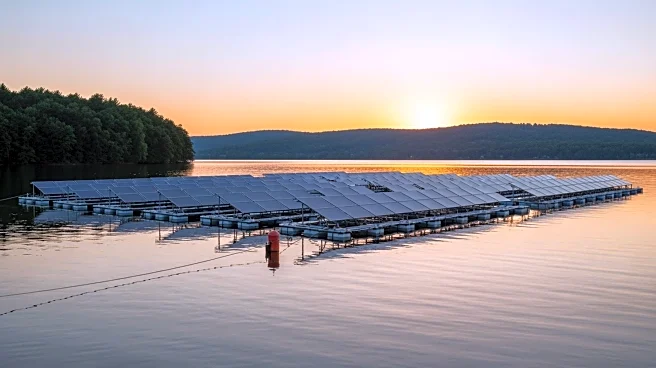What's Happening?
OUC—The Reliable One has inaugurated one of the largest floating solar arrays in the United States, located in Orlando, Florida. The 2-megawatt system comprises over 3,400 solar panels distributed across
two arrays, which send energy directly to the grid. This innovative project is part of OUC's strategy to diversify its energy generation portfolio, with solar now accounting for more than 10% of the utility's energy mix. The floating solar array is expected to power approximately 50,000 homes, demonstrating OUC's commitment to sustainable energy solutions. The project was developed in collaboration with D3Energy, a leader in floating solar development, and was facilitated by a right of way agreement with the Florida Department of Transportation.
Why It's Important?
The launch of this floating solar array marks a significant step in renewable energy adoption, contributing to the reduction of carbon emissions and enhancing energy sustainability. By increasing its solar capacity, OUC is positioning itself as a leader in clean energy, which could influence other utilities to adopt similar technologies. This development is crucial for meeting environmental goals and reducing reliance on fossil fuels, thereby benefiting both the local community and the broader fight against climate change. The project also highlights the potential for innovative solar solutions in urban areas, where space for traditional solar farms may be limited.
What's Next?
OUC plans to continue researching optimal designs for future solar projects, potentially expanding its floating solar initiatives. The success of this project may encourage further collaborations with state agencies and private companies to explore additional renewable energy opportunities. As solar technology advances, OUC's commitment to innovation could lead to more efficient and cost-effective energy solutions, benefiting its customers and setting a precedent for other utilities nationwide.
Beyond the Headlines
The deployment of floating solar arrays presents unique challenges and opportunities, including the need for specialized infrastructure and maintenance. However, it also offers advantages such as reduced land use and potential cooling effects on the panels, which can enhance efficiency. This project may inspire further exploration into hybrid solar systems that maximize energy generation while minimizing environmental impact.












